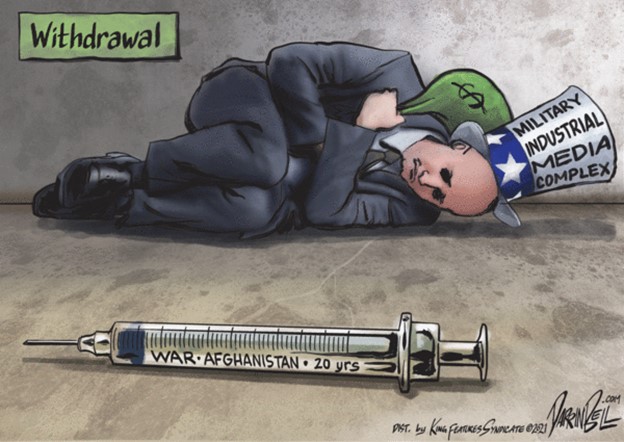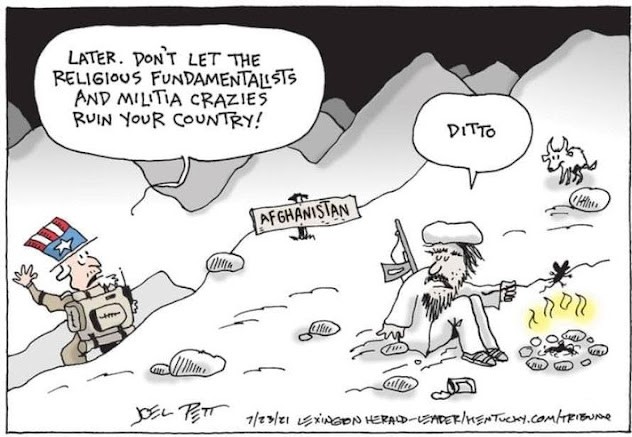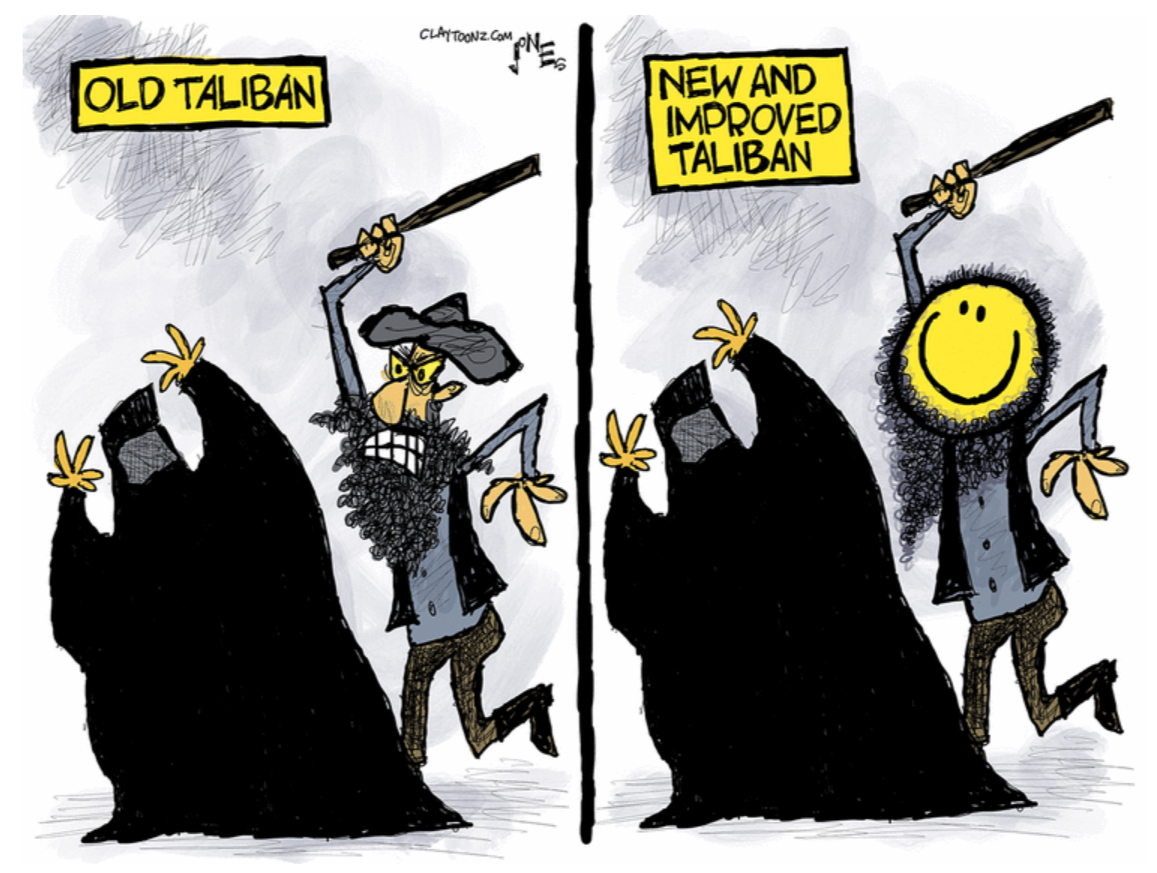The Daily Escape:

Sand Beach, Stonington ME – 2021 Photo by Erin Hutchinson Via Maine Nature Lovers
Billions of words will be written about America’s spectacular and embarrassing failure in Afghanistan. Today, let’s focus on a few of the failures in Afghanistan by our military. For context, America along with our western allies, have failed badly in the four Middle East wars we’ve engaged in over the past 20 years: Afghanistan, Iraq, Libya, and ISIS in Iraq (again), and Syria.
We’ve had 20 years to think about our goals, and to refine our military strategy and tactics. In each case, we fought an enemy that had no air or naval power, who largely had light weapons (rifles, machine guns and rocket grenades), light truck-type vehicles mounted with heavy machine guns, and the ever-present Improvised Explosive Devices (IEDs).
In Afghanistan, the Taliban enemy favored using speed and maneuver tactics over guerilla warfare.
The Guardian offers background on our military’s training in Afghanistan:
“It started its multibillion-dollar training of Afghan forces in 2002 and three years later took control of training both the police and military, so US military trainers have had nearly two decades to ready the Afghan forces for the Taliban insurgency.”
And when we took over standing up a national Afghan army, we began by transforming it from a mobile light-infantry force that was the equivalent of the Taliban’s, into a combined-arms service with army, air force, and special forces elements.
That is, we remade them in our military’s image and likeness.
This decision meant that the costs of training, equipping, and maintaining the Afghan National Army would be ruinous, but the US taxpayer was paying for it, so not a problem. We had to teach them map reading because our way of fighting is coordinates-based. We taught them to fly helicopters, and to maintain them. We taught them the logistics necessary to get spare parts and aviation gas to remote bases.
This created the self-licking ice cream cone, a self-perpetuating system that has no purpose other than to sustain itself. Our military’s task required advanced military weapons, supplies and training that could only be provided by our glorious military-industrial complex defense contractors.
It worked for 20 years.
There’s a US military agency called the “Special Inspector General for Afghanistan Redevelopment” (SIGAR) that monitors and audits our spending in Afghanistan. SIGAR found that since 2005, the US military had been attempting to evaluate the battle-readiness of the Afghan troops they had been training, but by 2010, acknowledged that its monitoring and evaluation procedures:
“…failed to measure…factors such as leadership, corruption and motivation – all factors that could affect a unit’s ability to put its staffing and equipment to use during actual war-fighting”.
By 2014, it was decided that those assessment reports should be classified, presumably to hide the poor results. SIGAR also found the US military was persistently over-optimistic about Afghan military capability, even though it had no reliable evidence to justify that assessment.
Know that the Generals in charge of Afghanistan through these many years weren’t dumb enough to think that they were building an Afghan army that could win a war with the Taliban. But they said just that. And according to the WaPo, they lied their asses off the whole time:
“In the summer of 2011, Army Lt. Gen. William Caldwell IV made a round of public appearances to boast that he had finally solved a problem that had kept US troops bogged down in Afghanistan….Under his watch…US military advisers and trainers had transformed the ragtag Afghan army and police into a professional fighting force that could defend the country and keep the Taliban at bay.”
More:
“…later….Caldwell said….the Obama administration’s decision to spend $6 billion a year to train and equip the Afghan security forces had produced a remarkable turnaround. He predicted that the Taliban-led insurgency would subside and that the Afghans would take over responsibility for securing their country by the end of 2014, enabling US combat troops to leave.”
Now we see the reality: (emphasis by Wrongo)
“…according to documents obtained for the forthcoming Washington Post book “The Afghanistan Papers: A Secret History of the War,” US military officials privately harbored fundamental doubts for the duration of the war that the Afghan security forces could ever become competent or shed their dependency on US money and firepower…..Those fears, rarely expressed in public, were ultimately borne out by the sudden collapse this month of the Afghan security forces…”
The US military leaders lied – to Congress, and to the American people. They classified the data that their lies were based on, so oversight was mostly impossible. If you need to lie for 10 years about the progress you’re making on the job, it’s likely that you’re bad at your job, the project is simply wrong on its face, or both.
And this week, despite Biden and others saying it was a complete surprise that Kabul fell without a shot, US intelligence officials admitted to NBC on the condition of anonymity, that there was in fact intelligence indicating a Taliban takeover could happen as quickly as it did. A Western intelligence official said:
“…there absolutely was intelligence reporting that it could happen this fast. This was not a surprise.”
A US official said: “we knew the Taliban would take over….We knew most Afghans wouldn’t fight. It was faster than expected, but not that much.”
Now they tell us. What they told us for 10+ years was a pipe dream. That’s why it’s folly to listen to former generals and politicians who suggest that things would have been any different if we waited another six months before withdrawing.
There’s plenty of blame to go around, but the bulk of it falls on the military. They were on the ground.
- They were the ones who built an Afghan military that was completely unsuitable for the battle at hand.
- They apparently never grasped the full extent of the Afghan corruption that was undermining the mission.
- They advised four US presidents that things would work out if they could just have a little more time and a few more troops.
No one wants to be the bearer of bad news. No one wants to admit they can’t do the job they’ve been tasked with. These things also happened to the generals in Vietnam, and the Pentagon swore at the time it would never happen again.
But it did, once they found themselves in a similar situation.
We shouldn’t forget that the Afghan military did fight. They’ve been fighting for years, taking many more casualties than we did. According to Brown University, about 70,000 of them died during the same period that the US military lost 2,442. Many in the Afghan military hadn’t been paid in months. Some were sent to remote bases to fight without food and other basic supplies. No wonder they surrendered their weapons without a shot.
As a former US Army officer, Wrongo is sad to say that Afghanistan will be remembered as a great shining military disaster, a head-on collision of the neo-con nation-building fantasy with reality.






 Bush famously painted us in the corner of both Iraq and Afghanistan:
Bush famously painted us in the corner of both Iraq and Afghanistan:


















